தமிழில் மிகத் தொன்மையான புறநானூறு மற்றும் அகநானூறு பாடல்களில் முழுவதும் ஆங்காங்கே கோவில் இறை வழிபாடு மற்றும் வேதங்களைப் போற்றும் மெய்யியல் மரபைக் காண்கிறோம்.
வரலாற்று காலத்திற்கு முன்பு
பீம்படுகா பாறை வசிப்பிடங்கள் என மத்தியப்பிரதேச மாநிலத்தில் 1 லட்சம் ஆண்டுகளாக வாழ்ந்தது அகழாய்வில் கண்டுபிடிக்கப்பட்டது. இந்த குகைப் பாறைகளில் தங்கள் வாழ்வினை வெண்/சிவப்பு சாந்து கொண்டு வரைந்த கோடு படங்களில் மிகப் பழமையானவை 30,000 ஆண்டுகள் தொடங்கி பொஆ.முதல் நூற்றாண்டு வரை என அறிஞர்கள் கணித்து உள்ளனர்




தலா தேவ்ராணி- ஜெதானி கோயில், சட்டிஸ்கர் மாறுபாடான ருத்ர சிவமூர்த்தி திருவுருவம்!!!
பழைய உஜ்ஜயினி காசில் சிவபெருமான் கையில் கமண்டலம், பொமு 2ம் நூற்றாண்டு Ujjain city state c. 2nd century BC AE coin (15 mm, 2.17 g)Obverse: Male deity Mahakal (Siva) standing right, holding Kamamdal; tree-in-railing to left Reverse: 4-orbed Ujjain symbol Ref: Pieper 281https://www.vcoins.com/.../india.../1257900/Default.aspx
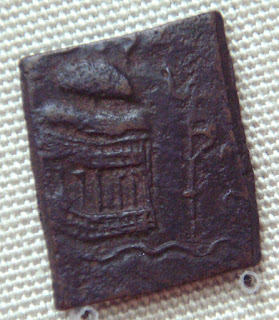
பொயுமு187- இல் மௌர்ய பேரரசின் வலிமையற்ற வேந்தனான ப்ரஹத்ரதனைக் கொன்று விட்டு தளபதியாக இருந்த புஷ்யமித்ரன் அரசனான். இவனில் துவங்கிய சுங்க வம்சம் அந்தப் பேரரசை நூற்றுப்பத்து ஆண்டுகள் நடாத்தியது. மௌர்யர்கள் பரப்பியிருந்த பௌத்தத்தை நீக்கிய செயல் இவர்களுடையதே. புஷ்யமித்ரனின் மகனான அக்னிமித்ரனே காளிதாஸனால் தனது மாளவிகாக்னிமித்ரத்தில் கொண்டாடப்பெற்றவன். இவர்கள் காலத்தில் பலவிதமான வழிபாடு தொடர்பான கற்பலகைகள் கிடைக்கின்றன. மதுராவில் கிடைத்த இந்த இரண்டு கற்பலகைகளும் மிக இன்றியமையாதவை. ஒரு பலகையில் லிங்க வழிபாடு தெற்றென விளக்கப்பெற்றிருக்கிறது. கின்னரர்கள் இருபுறமும் மாலையேந்தி நிற்க நடுவே மரத்தடியில் சிவலிங்கமானது வீற்றிருக்கிறது. மற்றொரு கற்பலகையில் ஏகமுக லிங்கமானது வீற்றிருக்கிறது. இதுவும் மரத்தடித் திண்ணையில் வீற்றிருக்கும் வண்ணம் அமைந்திருக்கிறது. இவையிரண்டும் பொதுயுகத்திற்கு முன்பு லிங்க வழிபாடு எப்படியிருந்திருக்கும் என்பதற்கு அடையாளமாக அமைந்துள்ளன. 

அரப்பாவிற் கிடைத்துள்ள ஆண்சிலையொன்று இடது காலைத்துக்கி வலது காலையூன்றி நின்று நடம்புரியும் நிலையிற் காணப்படுகின்றது. இதனைச் சிவபெருமானுக் குரிய திருவுருவங்களில் ஒன்றான நடராசர் திருவுருவின் முதலுருவமாகக் கருதுவர் ஆராய்ச்சியாளர்.
சிவன் தலையாய யோகிமட்டும் அல்லர்; விலங்குகட்கெல்லாம் தலைவர் (பசுபதி); சிவனுக்குரிய இவ்வியல்பினையே சிவனைச் சுற்றி யானை புலி காண்டாமிருகம், எருது என்னும் நான்கு விலங்குகள் நிற்கும் தோற்றம் காட்டுகின்றது. சிந்துவெளிக் கடவுளின் தலையில் அமைந்துள்ள கொம்புகள் பிற்காலத்திற் சிவனது சிறப்புத் திருவுருவம் ஒன்றைக் குறிக்கும் நிலையில் மூவிலைச் சூலமாக மாறியது. இவற்றையெல்லாம் நோக்கும்போது பிற்காலத்திலே சிவனுக்கு அமைந்த பல அமைப்புக்களின் தோற்றநிலைகளே சிந்து வெளி முத்திரைகளிற் காணப்படுகின்றன என நாம் கருதலாம்”.
யௌதேயர்கள் சிற்றரசர்களானாலும் தம்மை அசைத்துப் பார்த்த குஷாணர்களையே கலகலக்கச் செய்தவர்கள். அவர்தம் காசுகளில் கார்த்திகேயன் வீற்றிருந்த எழிலைப் பார்த்தோம். இந்தக் காசு கார்த்திகேயனின் ஆலயத்தைத் தனக்குள்ளே கொண்டுள்ளது. முன்னர் மானை வைத்து ஆலயம் எழுப்பியிருக்கிறார்கள். மானைக் கார்த்திகேயனுக்கு வாஹனமாகிய நிறுத்திய காரணம் தெரியவில்லை. ஆனால் பழைய காசுகளில் கார்த்திகேயனுக்கும் திருமகளுக்கும் அருகே மானை வைக்கும் வழக்கம் இருந்திருக்கிறது. இதன் காலம் பொயு ஒன்று முதல் இரண்டாகத் தீர்மானிக்கப்பெற்றுள்ளது.
சிந்துவெளி மக்கள் கடவுள் வழிபாட்டிற் பயன்படுத்திய திருவுருவம் சிவலிங்கங்களே. அரப்பாவில் மட்டும் சிறியனவும் பெரியனவுமாக ஏறக்குறைய ஆயிரம் சிவலிங்கங்கள் கண்டெடுக்கப்பெற்றுள்ளன. சிறிய சிவலிங்கங்களை அக்கால மக்கள் இக்காலத்து வீர சைவர்களைப்போன்று தங்கள் கழுத்திலும் கையிலும் கட்டிக்கொண்டிருத்தல் கூடும். இதனால் சைவ சமயத்திற்கேயுரிய சிவலிங்க வழிபாடு ஐயாயிரம் ஆண்டுகட்குமுன் சிந்து வெளியிற் சிறந்து விளங்கியதெனபது நன்கு துணியப்படுதல் காணலாம்.
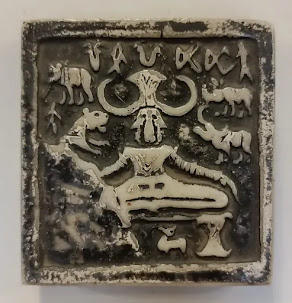
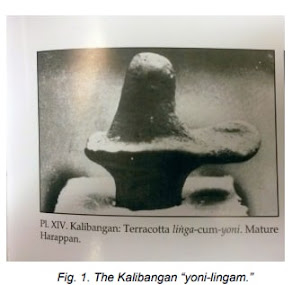
மேலே கண்ட தரவுகளை அந்தந்த துறையில் உச்சத்தில் போற்றப்படும் அறிஞர்கள் இவற்றை கூறினாலும் இன்றைய அறிஞர்கள் சிலபலர் இவை நிச்சயமாக கூற இயலாத கருத்துக்கள் எனக் கூறுகின்றனர்


ஆந்திர மாநிலத்தில் கர்னூலை அடுத்த வீரபுரத்தில் கிடைத்த இந்த விநாயகரே மிகவும் பழமையான விநாயகர். சுடுமண்ணால் ஆன இந்த வடிவம் ஐராவதம் மஹாதேவன் அவர்களால் கண்டெடுக்கப்பெற்றது. சாதவாஹனர்களின் காலத்தைச் சேர்ந்ததாகக் கருதப்பெறும் இதன் காலம் பொயுமு இரண்டாகலாம் என்று கருதப்பெறுகிறது. பொயுமு இரண்டிலேயே ஆந்திரத்தில் வழிபாடு இருப்பதால் தமிழகத்திலும் இருந்திருக்கலாமென்பதே பலரின் கருத்து..



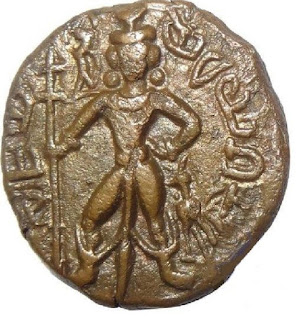
A Bronze Seal of first Century CE was unearthed in 1914-15 by Marshall on the Sirkap site of Ancient Taxila in Punjab of Pakistan which contained the figure of Shiva with two arms with a bilingual legend in Brahmi and Karoshti scripts as "SHIVARAKSHITASA". This seal shows a Club being held in right hand in a knotted pattern as seen for Heracles. Maues ( 60-50 BCE ) is the earliest of Pre Kushana rulers who had adapted this in his Square Copper coins where Shiva holding the Trident and Club are shown. It is said that in a variant Coin by Maues we can also see a Dwarf trampled under the feet of Shiva. Unfortunately I could not source images of these coins as they are very rare but documented, in British Museum, not on public display. In the same pattern Shiva with a Trishula is being shown in the coins of Gondophares ( 30-15 BCE ) with a Palm tree being held in an extended right hand. Posture seen in Sirkap Seal is different from that seen in Gondophares and Vima Khadphises coins; the left leg is placed similarly in all, whereas the right leg with bent knee is stretched forward in the Seal. The Indo Greek coins showing Heracles with a club are of the same pattern of the Club element. The Indian loin cloth and Turban on the head are starkly in contrast with the Shiva figure shown in a Hellenistic Style. Bronze seal No.12 unearthed at Sirkap, Taxila, was described by Marshall in ASI Archaeological Review 1914-15 ( Page 15, Pl. XXIV, 50 ) as Heracles trampling a bull shaped Dragon. The Kharoshti legend was read by him as Tidusa Vibhumitrasa while Konow read it as Badusa Vispamitrasa translated as "Of the Young Brahman Visvamitra". This probably depicts Shiva as Vishwamitra, the name of the person in this Seal being after the name of the God depicted. The Bull below the left leg of the main figure is significant. These names are frequently also seen as various forms of Shiva ( on some silver coins of Audumbara Chief Dharaghosha ) and one of his aspects is well known to us as Vatuka Bhairava. Maues Square coins in British Museum are documented in detail by Gardner, who explains it as a Male figure with Chlamys flying behind, holds a club and Trident. A similar one is also seen in Punjab Museum in a Maues coin with the Male deity striding to left with flowing draperies, holding a club in right hand and long spear or Sceptre in left. The Script Shivarakshitasa means "One Protected by Shiva" and the Coin with this script shows almost exactly the same form of Shiva from other coins, with his Trident held on left hand resting on his left shoulder and a knotted Club in right hand. From these we can infer that in Coinage the first to depict Shiva were indeed the foreign rulers of Ancient India and also evidently earlier to Gondophares. Similarly Cunningahm's "Coins of Indo-Scythians and Kushans" ( Page 30, Pl.II,Fig13) it is explained that a male figure facing front is seen with an elephant goad over the left shoulder. The Ankusa being Shiva's attribute is also seen in Kanishka and Huvishka coins and so it should be Shiva only. Maues coins show only a Trishula in Shiva's hand and sometimes a dwarfish figure being trampled is frequently interpreted as Poseidon. This is also seen in the coins of Antimachus Theos. Obviously in an Indian perspective we cannot help being reminded of the Apasmara Purusha under Shiva's feet.




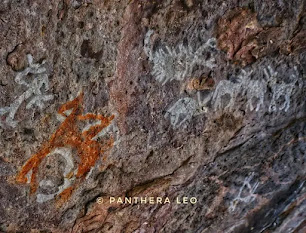



















No comments:
Post a Comment